Adam Yamey's Blog: YAMEY, page 227
August 6, 2019
The Patient Assassin
[image error]
I love browsing in second-hand bookshops. Occasionally, I come across really good books that I had not previously known about. The Patient Assassin by Anita Anand (published 2019) was one such discovery.
The Patient Assassin is about the life and exploits of Udham Singh (1899-1940), a pro-independence, anti-British activist. Some of his friends were killed in the notorious Jallianwalla Bagh massacre in mid-April 1919. Under the command of General ‘Rex’ Dyer, several hundred innocent men, women, and children, were shot dead within the closed space of Jallianwalla Bagh, a walled public garden in Amritsar. Many others were injured in this cruel attack whose supposed purpose was to subdue the people of the Punjab so that they would not rise against British rule.
Dyer died of illness in England, having been proclaimed a hero for his malevolent deed. Michael O’ Dwyer, the Lieutenant Governor of the Punjab, who thoroughly approved of what was done at Jallianwalla Bagh and other horrific treatment of Indians, retired to London.
Udham Singh had friends who were killed at Jallianwallah Bagh. He made it his mission to kill O’ Dwyer. The author of Patient Assassin, Anita Anand, traces Udham’s complex and mysterious life from the Punjab to London, where he shot dead O’ Dwyer at a meeting at London’s Caxton Hall in 1940. Ms Anand weaves an exciting tale based on her researches of Udham’s colourful and exciting life. Her book about a real person makes far more engaging reading than most fictional thrillers.
I was very pleased to stumble across Anand’s book for two reasons. One is that it turned out to be an un-put-downable read. The other is that it chimes with something that I have been working on.
In mid 1909, Madan Lal Dhingra, who like Udham Singh came from the Punjab, shot dead Sir William H Curzon Wyllie, a retired important British administrator in India, at the Imperial Institute in South Kensington. This assassination horrified the British nation and many in India.
Dhingra had come to England study engineering at University College London several years before shooting Curzon Wyllie. He had become involved in the freedom fighting activities that were centred on India House in Highgate between 1905 and early 1910. It was Dhingra’s fatal shots that hastened the demise of India House, a student hostel and meeting place which was regared by the British as a ‘centre of sedition’. I have almost completed writing a book about India House and its members, including Dhingra, and it should be available for sale soon. Its title will be “Ideas, Bombs, and Bullets”.
Finding Ms Anand’s book quite by chance was a great delight for me. Unintentionally, it might almost be considered a kind of sequel to what I have just written.
August 5, 2019
A line of bollards
[image error]
Keeping cars off pavements,
Lined up like soldi-ers:
Praise London’s bollards
August 4, 2019
This won’t hurt a bit!
[image error]
One of my dental colleagues, a very confident fellow and a competent operator, told me this true story many years ago.
One day, he had a nervous male patient, a well-built strong looking man. However, the patient was extremely anxious, as many dental patients often are. The patient needed to have root canal treatment and was convinced that he would experience much pain during the procedure.
As my colleague prepared his local anaesthetic syringe, he said, trying to be reassuring:
“Don’t worry, sir, after I have given you this injection, the procedure won’t hurt a bit!”
The patient turned to my colleague brandishing his tightly clenched fist, and said:
“You’d better be right because this will certainly hurt you!”
Photo by Pixabay on Pexels.com
August 3, 2019
St John’s finger
[image error]
It might have been in the Bargello, or more likely in the Museo dell’Opera del Duomo, both in Florence (Italy), that there was (and probably still is) an exhibit that captured my imagination when I was a young child. Amongst a collection of holy relics housed in elaborately crafted silver and glass containers, there was one holy relic that looked a bit like the stub of a discoloured cigar. It was, so the museum label stated, a bone from the index finger of St John the Baptist. Whether it was or was not, this item fascinated me, and even haunted me.
Many years later when I was looking into the story of St Appolonia, the patron saint of dentists, I read that one of the miraculous properties of the body parts of dead saints is their ability to reproduce themselves – a feature that must have been useful for those who used to sell such things. I am glad that I had not known this when I used to stare fascinated at St John’s finger, which I then believed to be exactly what it claimed. That would have spoilt my amazement, which I always felt when I saw that piece of bone in its ornate container.
Photo from flickr
August 2, 2019
We did not mean to visit Dubai
[image error]
I must admit that Dubai was never on the long list of places that I hope to visit during my lifetime. It was a place that, without any rational explanation, I felt like avoiding. Benidorm is another of these places, as are, for example, EuroDisney, Ayia Napa, Eilat, the Seychelles, and Sharm El-Sheikh. However, when flying on the excellent Emirate Airways, it is necessary to change ‘planes at Dubai’s fantastic airport.
A few years ago, we flew from London to Bangalore (India) by Emirates, This entailed changing ‘planes at Dubai. After embarking at Heathrow Airport, we were told that our departure would be delayed while a defective aircraft component was changed. Consequently, we departed about two hours later than we should have. As a result, we missed our connection in Dubai.
At Dubai, we were directed to a desk that dealt with connection/transfer problems such as that we faced. An extremely helpful man with an exuberant moustache and beard offered to put us on the next flight to India, which would have taken us to Bombay rather than Bangalore and advised us that from Bombay, we would no longer be in the care of Emirates. This did not sound satisfactory. Then, he said:
“If you are not in a hurry, why don’t you spend a day in Dubai and take the next day’s Emirate flight to Bangalore?”, adding quickly, “Emirates will put you up in a hotel and pay for our meals and accomodation.”
We opted for that, and within a few minutes we were whisked in a limousine to a hotel close to the airport. There, we were settled in two adjoining luxurious rooms.
Next morning, we decided to see Dubai as we had most of the day to do so. We bought day tickets for the city’s superb rapid transit rail service and visited the oldest part of Dubai, on the Creek. At the Creek, we bought day tickets for the small boats that criss-cross the Creek.
Without going into detail, we had a wonderful day in Dubai, travelling on boats, visiting museims and historic buildings, and eating superb middle-eastern food. Almost everyone we met was friendly and helpful.
Although I would not choose to visit Dubai again unless we have to because of a missed ‘plane connection, our day in Dubai removed my previous completely unjustifiable prejudice against visiting the place. Our delayed Emirates flight did us and Dubai a great favour!
August 28, 2018
LOOKING THROUGH STONE IN GUJARAT
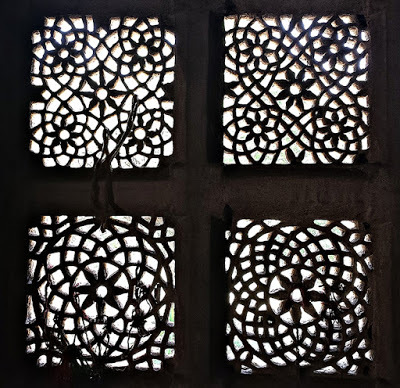
Baroda
Before setting out on our recent extended travels through Gujarat, I booked accommodation via a well-known travel website. The hotel I chose for Ahmedabad was the aptly named ‘Hotel Goodnight’. Its address, ‘Opp.
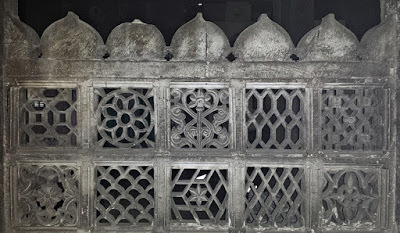
Ahmedabad
The word ‘jali’ (or ‘jaali’) means ‘net’ in Hindustani. As an architectural term, it refers to stone grille window screens. These screens are carefully and usually intricately carved in stone (usually). A flat stone is carefully perforated to produce an often elaborate pattern of spaces surrounded by the remaining strands of stone. In India, they are found in temples (Hindu and Jain), mosques, and secular buildings. They are usually very attractive. These carved stone window coverings, that simultaneously provide shade and the passage of light, can be seen outside India. There is at least one church in Palermo (Sicily), which contains jali work. In this case, it was created by Moorish craftsmen who remained in Sicily after it was conquered by the Normans.
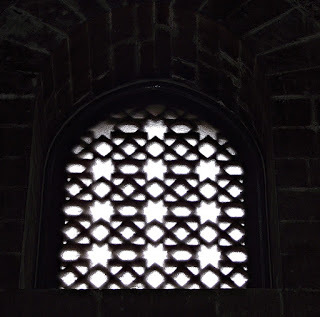
Palermo (Sicily)
Jali work can be found not only in buildings constructed many centuries ago, but also in more recently built structures, such as the Arts Faculty Building in Baroda and the Vijay Vilas Palace in Kutch Mandvi.
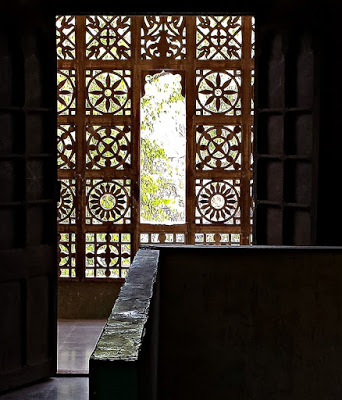
Baroda Faculty of Arts (19th century)
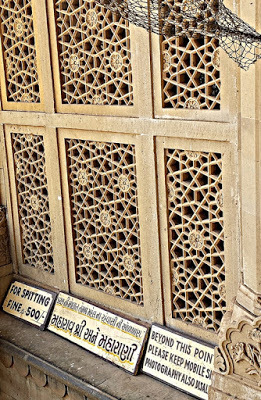
Vijay Vilas (Kutch Mandvi)
The best places in Gujarat for seeing jali, which we visited, were Ahmedabad and Baroda. If you don’t wish to travel so far afield, The Victoria and Albert Museum in London has some very fine examples in its South Asian galleries.
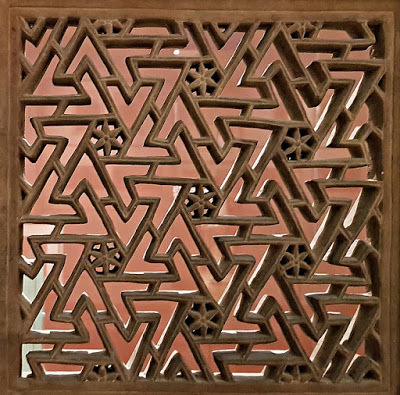
In Victoria and Albert Museum
Returning to Sidi Saiyed’s Jali in Ahmedabad, here is an excerpt from my new book:
“Opposite our hotel and across the busy Relief Road, which one should not cross without first saying a prayer, is one of the city’s many architectural treasures. It is the Sidi Saiyed Mosque (aka: ‘Sidi Saiyed’s Jali’), which was built in 1573 during the last year of the Gujarat Sultanate. It was constructed by Sidi Saiyed, an Abyssinian general in the army of Sultan Shams-ud-Din Muzaffar Shah III. A learned man with a great library, he had served with Rumi Khan, a son of Khwajar Safar, who died at Diu. The Sidi’s grave lies in a wire mesh enclosure near the north east corner of the mosque. His much-revered gravestone is usually covered with beautiful coloured silk cloths.
This mosque is a long rectangular open-fronted pavilion. It is entered through any of five wide arches with pointed tops. The mosque’s domed ceiling is supported by four rows of pillars each supporting arches, which together form an arcade. The stonework is decorated in places with floral motifs that are not especially Islamic. The lower part of the rear wall facing the entry arches is plain stonework apart from a centrally placed mihrab. The upper third of this wall has five almost hemi-circular stone arches. The central one is solid stonework. It is flanked on either side by pairs of exquisite, intricately perforated stone lattice screens, exceptional examples of jali work. They allow light to filter into the mosque from the west. The screen at the south end of the mosque is carved to represent a Tree of Life with swirling, tangled branches…”
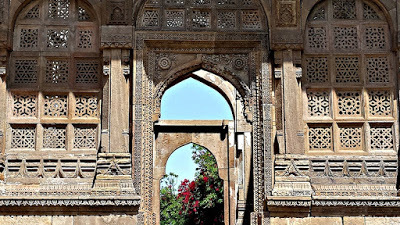
Champaner
READ MORE ABOUT GUJARAT IN ADAM YAMEY'sLATEST BOOK
AVAILABLE in PAPERBACK by clicking HERE
DOWNLOAD on to your KINDLE by clicking HERE

August 24, 2018
OPEN YOUR EYES TO GUJARAT
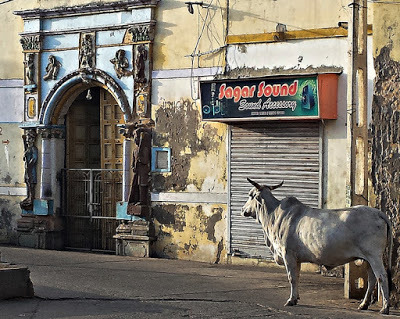
DISCOVER GUJARAT AND THE FORMER PORTUGUESE COLONIES OF DAMAN AND DIU
"Gujarat, the land of Gandhi and Patel, is also the land of business"[Narendra Modi, 2017]
Almost wherever you live, you are bound to have met members of the Gujarati diaspora. Yet, Gujarat in western India, where they originated, is hardly known or visited by foreign and Indian tourists.Adam Yamey’s richly illustrated book describes his travels through Gujarat and two former Portuguese colonies, Daman, and Diu, with his wife. Her knowledge of Gujarati allowed the travellers to speak with locals and gain their insightful views about Gujarat’s past, present, and future.
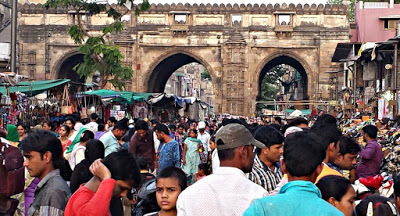
Join Adam and his wife in their adventures through the land where Mahatma Gandhi grew up and Lord Krishna ascended to heaven. Meet the people and discover places whose beauty rivals the better-known sights of India.
This book will be of great interest to tourists. It is an insightful personal view of the region rather than a guide book.
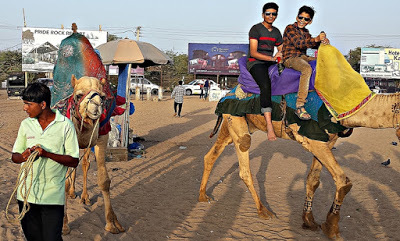
GET TO KNOW GUJARAT WITHOUT LEAVING YOUR SEAT:

BUY THE PAPERBACK H E R E

DOWNLOAD ONTO YOUR KINDLE H E R E
August 16, 2018
THREE HAIKUS
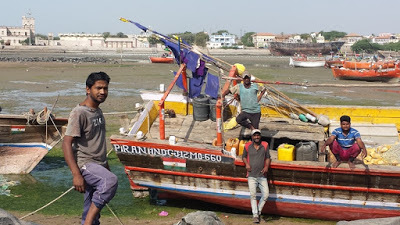
Two forts and a river, much Portuguese heritage: that is Daman.
Gujarat: land with colour, history, and warm personality.
Oh! Did you know Diu was once a colony of the Portuguese ?
Discover more about Gujarat, Daman, and Diu here:
https://gujarat-travels.com/
August 10, 2018
GUJARAT - a new link
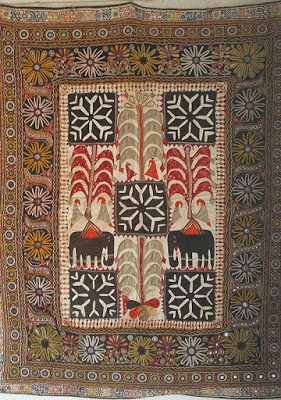
GUJARAT has been an important trading area since time immemorial and a place where diverse peoples have mingled. It offers the visitor a rich cultural tapestry: history, tradition, architecture, and much more. Its people are welcoming.
Good accomodation is available, and transportation is not a problem.
Find out more about GUJARAT at this exciting new website:
https://gujarat-travels.com/
August 5, 2018
STYLE FUSION IN GUJARAT
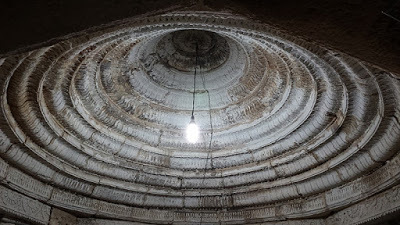
Temple ceiling at Somnath
Turkic forces of the Muslim Delhi Sultanate began conquering parts of Gujarat in the 14th century. Even before that, Muslim forces had invaded the region. In the early 11th century AD, Mahmud Ghazni (971-1030) arrived at Somnath, and ordered the destruction of the great temple he found there. Zafar Khan (Muzaffar Shah I, died 1411), a Hindu who converted to Islam, later destroyed another temple built on this site. At least one Muslim ruler was tolerant of the Hindus and Jains living in Gujarat. According to Satish Chandra, author of History of Mediaeval India, Firuz Shah Tughlaq (reigned: 1351-88) encouraged the Hindu religion and promoted the worship of idols. Generally, the 14th and 15thcentury rulers of Gujarat were unlike Firuz with regard to tolerating Hinduism and its temples. Yet, the mosques and other important structures they built show many influences of Hindu temple design.
When the Muslim regimes began to be established in Gujarat, they faced a problem, which is well put in Architecture at Ahmedabad, Theodore C Hope (1831-1916): “The problem which the Mahomedan dynasty and its newly-converted adherents set themselves to solve was extremely similar to that presented to the Christians in Italy some ten centuries earlier. In both cases the object was to convert a Pagan style of architecture to the purposes of a religion abominating idolatry.”
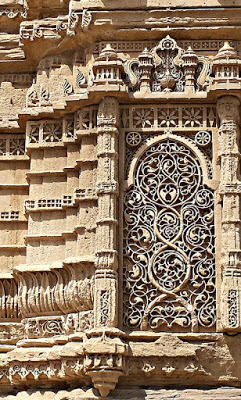
Champaner:detail of a mosque
What resulted is what we found in Gujarat: 15th century mosques and Islamic mausoleums with significant architectural similarities to the local style of Hindu temple architecture of that era and before. What distinguishes Islamic buildings from the Hindu structures that influenced their design is the lack of figurative sculptures and decoration and the presence of minarets and mihrabs. This fusion of styles is nicely put on a placard we saw at Sarkhej Rauza near Ahmedabad: “… the early Islamic architectural culture of the region, which fused Islamic influences from Persia with indigenous Hindu and Jain features … The architectural style of Sarkhej Rauza is a precursor to the Mughal period in a true amalgamation of Hindu, Jain, and Islamic styles. Hindu craftsmanship and construction know-how was overlaid on Islamic sense of geometry and scale”
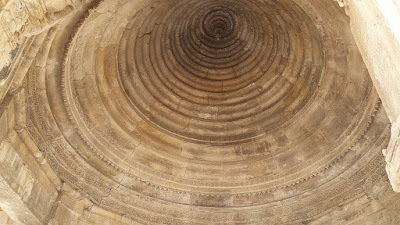
Champaner: ceiling of a mosque
LEARN MORE ABOUT GUJARAT by clicking HERE:
https://gujarat-travels.com/



